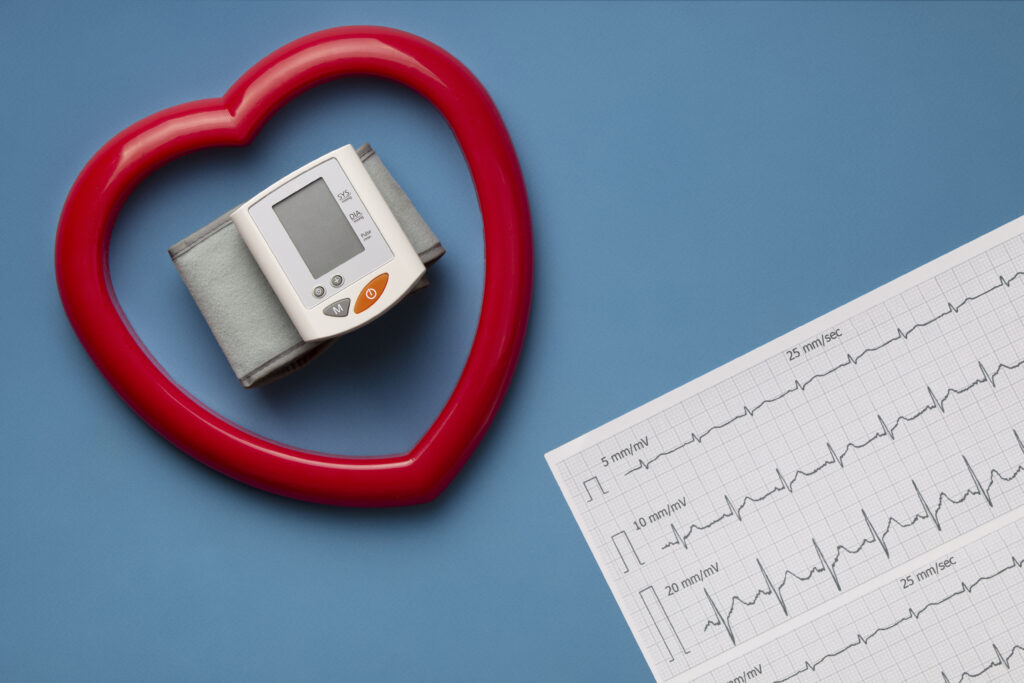irregular ventricular response.
The classification of atrial fibrillation is based mainly on the duration of the arrhythmia and the intensity of its symptoms of irregular heartbeat. We distinguish the following types:

Paroxysmal atrial fibrillation resolves spontaneously, usually within 48 hours of the onset of the arrhythmia. Persistent atrial fibrillation lasts longer than a week. We talk about long-term persistent atrial fibrillation when the symptoms of cardiac arrhythmia persist for more than a year. Persistent atrial fibrillation can persist for years, but the patient accepts it.
The list of factors predisposing to the development of AFib is quite long. It includes, among others we have causes like:
There are situations when the cause of AFib cannot be determined. In such cases, it is referred to as idiopathic.
AFib typically arises from changes that impact the heart and its associated vessels. These changes often stem from diseases affecting the circulatory system, including the heart and respiratory systems. Additionally, other conditions – such as metabolic, hormonal, or disorders related to the autonomic nervous system – can also increase the likelihood of developing atrial fibrillation.
An episode of AFib may occur due to certain medications, electrolyte imbalances, severe infections, or significant physical exertion, such as marathon running.
Examples of disorders that can cause atrial fibrillation:
Although intense physical activity can trigger an attack of AFib, people with the disease should not completely give up sports and physical activity. At first, you can go for long walks, then replace them with walking, Nordic walking, or cycling. People with the disease can also try aerobics or gymnastics at home. Moderate exercise increased the heart's immunity and efficiency, while slowing its rhythm.
Sports also have a positive effect on well-being and increase motivation to take care of the health of people with AFib Physical activity should always be consulted and monitored by the attending physician.
An equally important issue is whether you can work in your current profession with atrial fibrillation. There is really no clear answer to this question. It all depends on the type of disease, the frequency of attacks, comorbidities, the symptoms, the treatment used, and its effectiveness. A doctor decides whether a given person is fit to work based on the above-mentioned factors.
If the test results are good and the patient does not experience any unpleasant symptoms while performing their professional duties, they can still work. Atrial fibrillation, which worsens at work, especially when it is physical or stressful, is an indication of a change of job or retirement.
Symptoms of atrial fibrillation include:
The consequences of atrial fibrillation can be very serious, so it is important to remember that presyncope, fainting, and pain in the sternum require urgent contact with a doctor, and should not be underestimated under any circumstances.
Symptoms of AFib are not so typical in some cases, especially in older people with long-term arrhythmia. Asymptomatic atrial fibrillation is detected accidentally, e.g., during a pulse test, during blood pressure measurements with an electronic device, or on an ECG recording during a routine check-up at a doctor's office.

Atrial fibrillation without symptoms is a dangerous type of heart rhythm problem because it can lead to serious events like strokes. A person might not feel any irregular heartbeat but could still be at risk for complications for months if they don’t receive anticoagulant treatment. Regular monitoring for arrhythmia is very important, especially for people over 65 and those with hypertension or diabetes.
Most methods to detect arrhythmia are simple, non-invasive, and affordable.
You can check your pulse and heart rate yourself by feeling the radial artery on the inside of your forearm. Remember not to use your thumb when measuring your pulse. There are also many smartphone apps that can help you measure your pulse and check its regularity.
A resting ECG is a quick and easy test that you can have done at any medical office, and a doctor can interpret the results. If you have atrial fibrillation, the ECG will show an abnormal pattern, confirming the diagnosis and guiding treatment.
You can measure your blood pressure with automatic devices, many of which also check your heart rate. A normal heart rate is about 60–80 beats per minute. During an episode of arrhythmia, you may notice low blood pressure and a high pulse, and the blood pressure monitor might show errors, indicating an irregular heartbeat.
A Holter ECG is a test that records your heart activity for 24 hours, though it can be done for up to 3 days. This test is useful for spotting episodes of irregular heartbeats that happen from time to time. The recording device is small and light, and electrodes are attached to your skin with cables during the test.
People with devices like pacemakers, cardioverter-defibrillators, or resynchronization systems may need monitoring due to severe heart conditions or issues like serious heart failure or atrioventricular blocks. These devices can remember and store information about heart rhythm problems, helping doctors find any irregularities.
If heart issues are hard to detect because they happen rarely – maybe every few weeks or months – an implantable arrhythmia recorder can be used. This device can record heart rhythm for up to 3 years.
Anyone diagnosed with atrial fibrillation should have an echocardiogram (ECHO). This ultrasound exam checks how well the heart is working and looks for problems with heart valves, as well as the size and shape of the heart's chambers.
Restoring a normal heart rhythm is also called cardioversion. Doctors can perform this procedure using medication (pharmacological cardioversion) or by using electrical impulses that match the patient's ECG (electrical cardioversion).
During electrical cardioversion, an anesthesiologist helps the patient receive short-term general anesthesia so they sleep and don't feel pain during the procedure. The doctor applies two electrodes to the patient's chest, usually on the sternum and the left side or sometimes on the sternum and between the shoulder blades. These electrodes create an electric shock timed with the patient's heartbeat. Over 90% of the time, electrical cardioversion successfully restores a normal heart rhythm. However, some patients may experience atrial fibrillation again later.
Doctors only perform acute cardioversion in emergencies or if they know the person just had an episode of atrial fibrillation within the past 48 hours, especially if the patient is already on blood thinners. In other cases, patients need to be prepared with blood thinners for about 3–4 weeks before the procedure.
To reduce the risk of a recurrence of arrhythmia, appropriate drugs are used (most often a drug from the beta-blocker group or antiarrhythmic drugs). In people whose AFib recurs despite treatment, further attempts to restore sinus rhythm can be abandoned, provided, however, that the atrial fibrillation is well tolerated by the patient (does not cause significant discomfort). Atrial fibrillation is then defined as permanent. In such cases, chronic use of drugs that slow the heart rate (most often beta-blockers) and anticoagulation therapy is necessary.
In AFib, drugs are used when non-invasive therapy is possible. Patients are given:

Invasive methods of treating atrial fibrillation include:
In people with contraindications to long-term anticoagulant treatment (e.g., active peptic ulcer disease, bleeding from the gastrointestinal tract, previous hemorrhagic stroke), a plug implanted into the left atrial appendage can be used, which eliminates the entry of any clots into the arterial system.
AFib can be serious and pose risks to a person's life and health. It can disrupt blood flow in the body, which can lead to the formation of blood clots. These clots can cause embolisms and may result in an ischemic stroke. Atrial fibrillation is one of the leading causes of disability and can be fatal.
Ischemic stroke is a major complication of untreated atrial fibrillation and is responsible for stroke cases. Patients with atrial fibrillation face a higher risk of severe stroke impacts, including death and permanent impairment. AFib disrupts normal blood flow in the heart, leading to turbulence and clot formation. A clot traveling to smaller blood vessels can cause ischemic stroke or embolism in peripheral arteries, such as the femoral or mesenteric arteries. Clots in the right atrium may lead to pulmonary embolism.
Additionally, atrial fibrillation increases the risk of heart failure symptoms, as the lack of atrial contraction reduces heart efficiency by about 15%. This decrease may be negligible in those with normal heart function but can be significant in individuals with damaged hearts, potentially leading to life-threatening issues.
People with atrial fibrillation should know what to avoid in case of atrial fibrillation so that another attack of arrhythmia and complications dangerous to health and life do not occur. First of all, you should stop smoking. Substances contained in cigarettes and tobacco smoke have a negative effect on the entire body, especially the lungs and cardiovascular system. After smoking a cigarette, blood pressure increases, and the heart rate increases. In addition, carbon monoxide combines with hemoglobin instead of oxygen, which leads to hypoxia of the heart muscle and its dysfunction.
In the case of atrial fibrillation, you should also avoid drinking alcohol. Ethanol contained in various doses in beer, wine, and other alcoholic beverages causes blood vessels to dilate, accelerates blood flow, and thus causes the heart to beat faster, which can cause an arrhythmia attack. For their safety, people with atrial fibrillation should completely stop drinking beverages that contain even a small amount of alcohol.
What you do as a patient is very important in treating atrial fibrillation. Just taking medicine and following your doctor’s advice is not enough. You need to change your lifestyle to be healthier and keep track of your health regularly. This can help prevent arrhythmia from coming back and reduce the risk of serious problems. It also makes your treatment work better, helps you recover faster, and improves your quality of life.
We know what to avoid with atrial fibrillation. It’s also important to know how to take care of your health. First, focus on your daily habits, especially your diet, and staying at a healthy weight. If you have heart problems like atrial fibrillation, it’s a good idea to follow the Mediterranean diet. Its main assumptions are:
People who are ill should also report for medical check-ups and regularly undergo ECG tests, stress tests, Holter ECG, and laboratory blood tests, thanks to which it is possible to detect irregularities before the first symptoms appear.
Equally important is monitoring your health at home – primarily your heart rate and blood pressure. It is worth using a small, mobile, and easy-to-use device such as a portable ECG.
Table of Contents